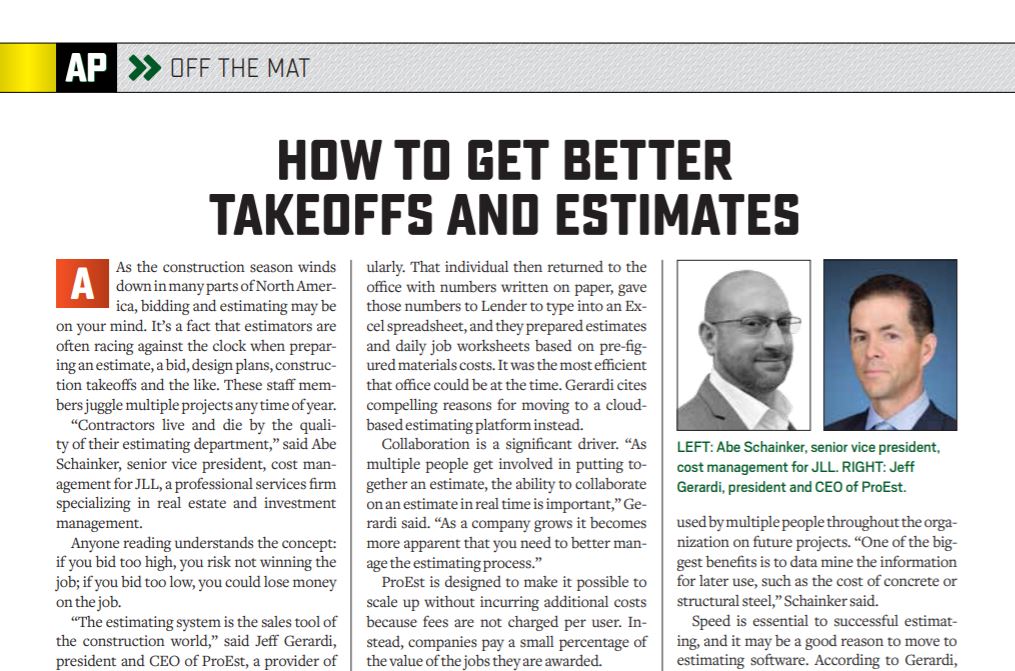How to Get Better Takeoffs and Estimates
BY AsphaltPro Staff

As the construction season winds down in many parts of North America, bidding and estimating may be on your mind. It’s a fact that estimators are often racing against the clock when preparing an estimate, a bid, design plans, construction takeoffs and the like. These staff members juggle multiple projects any time of year.

Abe Schainker, senior vice president, cost management for JLL
“Contractors live and die by the quality of their estimating department,” said Abe Schainker, senior vice president, cost management for JLL, a professional services firm specializing in real estate and investment management.
Anyone reading understands the concept: if you bid too high, you risk not winning the job; if you bid too low, you could lose money on the job.
“The estimating system is the sales tool of the construction world,” said Jeff Gerardi, president and CEO of ProEst, a provider of technology to automate the estimating and preconstruction process and an exhibitor at CONEXPO-CON/AGG 2020.
Obviously, you’ve got to win business to stay in business and that starts with a construction takeoff.
A construction takeoff determines how much material is needed to complete a job. Multiply by the number of units by the price of the material to calculate your material costs. Add in the cost of labor, equipment, subcontractors and administrative personnel, fees, insurance and desired profit. All of this goes into the estimate. The tools for the job have evolved over the years from hand scales and wheels to sophisticated software.
Estimating Software

Jeff Gerardi, president and CEO of ProEst
Microsoft Excel spreadsheets are the most common way to put together estimates. When Sandy Lender, editor of AsphaltPro, was preparing for in-depth understanding of the pavement preservation arena for our PavingPro and PreservationPro supplement products, she worked part-time in the office of a local sealcoating shop where one of the owners went out to measure jobs regularly. That individual then returned to the office with numbers written on paper, gave those numbers to Lender to type into an Excel spreadsheet, and they prepared estimates and daily job worksheets based on pre-figured materials costs. It was the most efficient that office could be at the time. Gerardi cites compelling reasons for moving to a cloud-based estimating platform instead.
Collaboration is a significant driver. “As multiple people get involved in putting together an estimate, the ability to collaborate on an estimate in real time is important,” Gerardi said. “As a company grows it becomes more apparent that you need to better manage the estimating process.”
ProEst is designed to make it possible to scale up without incurring additional costs because fees are not charged per user. Instead, companies pay a small percentage of the value of the jobs they are awarded.
“We want everyone to have access to the software,” Gerardi said. A cloud-based platform means that contractors don’t have to worry about maintaining or updating the system. Being accessible from anywhere is an advantage for an increasingly mobile workforce.
In Excel it’s more difficult to lock down standard pricing and productivities with multiple users. “If you want to re-use information and track historical trends, that’s where Excel is not going to be beneficial,” Gerardi added.
Schainker sees advantages to estimating software but he doesn’t believe it’s for everyone.
“Contractors may feel their templates are working just fine and they don’t want the added complexity,” Schainker said. “There are pros and cons to both options.”
The fact that Excel is included with the cost of a computer purchase makes it attractive. Excel spreadsheets are also very flexible and can be highly customized to a particular project.
Estimating software has the advantage when it comes to accessing data that can be used by multiple people throughout the organization on future projects. “One of the biggest benefits is to data mine the information for later use, such as the cost of concrete or structural steel,” Schainker said.
Speed is essential to successful estimating, and it may be a good reason to move to estimating software. According to Gerardi, ProEst users experience a 50% productivity gain versus Excel. Payback on the investment is typically achieved within one year. Contractors can determine an estimated ROI with a calculator on the ProEst website.
As discussed in this month’s New Tech department, Go iPave has launched its Instant Estimator add-on service for its users. This lets customers who would formerly use the measurements made with Go iPave to calculate time and material manually, to switch to an app that gives them real-time calculations.
“With Instant Estimator, users can get time and materials estimates in real time as they measure,” said Chris Ascolese, Go iPave’s head of business development.
With Instant Estimator, users create a library of services they offer and customize each service based on materials used and production rates. “They can do their job costing based on what they know their crew can do,” Ascolese said.
If you decide that estimating software is right for your business, look for those that integrate well with your construction management software. Integration means you can easily compare estimates with actual costs as you move from project conception to completion. The Equipment Manufacturers Association (AEM) pointed out on the CONEXPO-CON/AGG website, when it comes down to selecting bidding software it’s easy to be overwhelmed by the choices. If your work is focused in a single area, you can narrow your options by directing your attention to software geared to a specific market such as highway/heavy construction. These options are likely to have templates that are specifically designed for your type of work.
Use of Tools
Regardless of the tools used, estimators need to fully understand the construction process and how the estimate will be used.
“Estimating tools are only as good as the user that wields them,” Schainker said.
Sometimes owners ask for a preliminary bid and other times they want a full lifecycle analysis. At the beginning of a project, estimators may only be working with a description of the project, rather than drawings. “We have to price not only what is shown but the entire scope of the project,” Schainker said.
He cautioned that default unit pricing may not fully account for all the factors that can affect the price of materials and labor including construction volume, availability of key trades, and supply chain issues. “All of this needs to be reflected in your estimate,” Schainker said.
As an owner’s representative, he wants to be sure the contractor’s estimates are accurate, and there aren’t going to be any surprises. “I am not here to beat up on the contractor,” Schainker said. “Everyone has a right to make money.”
Build Talent In-House
Estimators in the United States often learn their skills on the job. Schainker believes few construction management programs give estimating the attention it deserves. Estimators are always in demand and
it’s difficult to find people with the right experience.
“The solution is to bring on more junior people and spend time teaching them how to read drawing and specifications,” Schainker said. “They need to learn how to ask the right questions.”
Unfortunately, it’s not uncommon to invest time training someone, only to have them leave.
“There’s no quick fix to the problem,” Schainker added.
Luckily for contractors, as Tom Webb, vice president of Products for HCSS, expressed on the CONEXPO-CON/AGG website, “Good software can help two estimators do the work of five.”
Based on Schainker’s experience, project overruns are usually a matter of the scope of the project changing without the budget being updated, rather than a failure of the estimator. Regardless, a final audit is a good way to identify what cost estimates were accurate and why there were variances on other projects.
